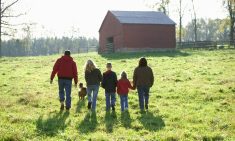Admittedly, it’s hard to say exactly what makes any innovation a success, or why farms are such fertile ground for new ideas. Maybe it’s the opportunity to test new ideas under real-world conditions. Or because farmers are so practical, or so resourceful, or because they know how to persevere.
Or, today, maybe it’s more likely to be the willingness to take a risk, or the determination to find the right people to help push the idea forward, or the talent for adapting to new ways of doing business.
Read Also

Farmland values: assumptions and realities
Where farmland values are headed and what decisions farmers should make
In fact, Kim Keller will tell you it’s all those traits together that help explain why her hot new farm app called Farm At Hand actually got its start in Saskatchewan farm country, a long, long way from the technology mecca of Silicon Valley.
It’s also why, in her role as Farm At Hand co-founder, Keller is seen as breaking a mold, while she sees herself drawing on a rich history of farm innovation, but doing it in a way that makes sense for the 21st century.
Making it fly
I visit Kim Keller’s family’s farm in late spring. The farm borders Gronlid, a small hamlet in north-east Saskatchewan where the Kellers have a park-like yard, maintained by Kim’s mother, Deb, who plants a truckload of flowers every year and eradicates any weeds that dare germinate in the bin yard. That’s no easy task, given there are about 50 bins in the yard.
Kim also introduces me to her dad, Rick. He shakes my hand and chats briefly before heading back to the field. He’s buoyant and relaxed despite being in the middle of seeding. The weather up to this point has favoured spring field operations.
Kim takes me on a tour of the 12,000-acre farm, and I shoot video of her dad and the Keller family’s two employees doing field work. Kim has flown here from her home base in Vancouver to run seed and otherwise support field operations this spring. She also helps out at harvest by driving the grain cart, and is at the farm frequently throughout the year.
After filming, we sit down at the Keller family’s kitchen table. The TV is tuned into CNN, Deb’s favourite news source, so Kim switches it off before we begin.
In the last couple of years, Kim has driven the 3,500-km round trip from Vancouver to Gronlid about 10 times. She’s also a frequent flyer, jetting to technology conferences and hitting agricultural trade shows around North America.
It’s a hectic life, but so is farming, she says. Hers is just a different type of hectic, and she’s willing to take it on to make Farm At Hand fly.
“This is a once-in-a-lifetime opportunity that we have,” Kim says. “There’s nothing I won’t do to make sure that we make the most of it.”
The path that led her to becoming an ag tech entrepreneur was unexpected. It started in 2011 when Kim realized she wanted something different than her career with a Crown corporation. It was like she woke up one day and wanted to be a farmer, she explains.
This change was a bit of a surprise for her. She had done the usual farm chores while in school, but otherwise wasn’t too involved. “Growing up, I never wanted to be a farmer,” she says. Instead, she earned a university degree and got a job, like many other farm kids who create lives for themselves in the cities.
Then her parents suggested she come back to the farm on a trial basis, and it was while running the grain cart during harvest that first fall that she had her spark of inspiration.
“I did everything else on my phone, but I couldn’t do anything meaningful for the farm on my phone,” she says. There were farming games and reference materials, but nothing to do with the business of farming.
Shortly after that harvest, Kim met Himanshu Singh through friends. Himanshu had just started a small software development company in Saskatoon. He was intrigued by Kim’s thinking about the lack of farm management apps, and asked her how her family tracked what was happening with their bins.
Kim explained they used a big sheet of paper on the kitchen island. Every time something changed in the bin yard, her brother Jeff would erase the old entry and pencil in the change.
Himanshu’s response was quick. “There’s got to be an app for this,” he said, so he and Kim went to work. “We did all of the research, and there wasn’t,” Kim says. “That’s how it all started,” and in February, 2012, they decided to build an app.
They didn’t intend to start a business, however. They simply wanted to create something for the Keller family farm.
But then, Kim’s family members quickly threw in their two cents about what they wanted in a farm management app, and what started as a tool to track bin yards and grain bags quickly evolved into a program to track field records (planting, spraying, harvesting, and scouting), contracts, contract deliveries and equipment maintenance and parts’ lists. “So it is farm management, basically seed to sale,” says Kim.
Light-bulb moment
On April 26, 2012, Farm At Hand made its debut.
“We ended up putting it on the app store because a couple of friends of mine and a couple of neighbours wanted to try it out,” says Kim.
Farm At Hand was, and remains, free for farmers, and within two months, they had about 500 downloads.
About three months after releasing the app, a market consultant gave Kim a call. All of his farmers were using the app, he said, and it was saving him a ton of time. It was a “light-bulb moment,” Kim says. She and Himanshu saw a business opportunity, and they decided to run with it.
In 2013, Kim and Himanshu had a chance to attend a technology accelerator to grow their business. But there was a catch. The accelerator was in Vancouver and they’d have to move there, at least temporarily.
Kim says leaving the farm was difficult. Vancouver wasn’t a place where she’d dreamed of living. In fact, neither Kim nor Himanshu had even visited there. But it was an opportunity for Farm At Hand, she says, “and there was no way that we were going to say no to opportunity.”
Over the August long weekend of 2013, Kim and Himanshu packed her truck and drove through the Prairies and mountains until they reached Vancouver. They’d rented an apartment, sight unseen, off Craig’s List, the online classifieds service.
“We slept on air mattresses for three months,” says Kim.
After they’d completed the accelerator program, they decided to stay in Vancouver to build their company. Recruiting staff to Vancouver was an easier sell, especially since Vancouver and Toronto are Canada’s tech hubs.
And Vancouver has its charms. Being downtown allows Kim to catch hockey and football games. “I can go watch the Riders play without having to drive four hours… I can just walk on over,” she says.
Today Kim and Himanshu have seven staff and the number of farmers using their app has topped 20,000.
They’ve also captured interest from industry. In April 2014, they raised over $1.4 million in funding from angel investors. With that funding, they can stay true to their pledge to keep offering the app to farmers for free while they’re also creating a paid version for agribusiness, which Kim says they plan to roll out by late 2015 or early 2016.
At this point, 90 per cent of Farm At Hand’s customers are in the U.S. and Canada — mostly in Western Canada and through the U.S. Grain Belt, Kim says, but the company is also gaining customers in South America, South Africa, the United Kingdom and Australia.
No matter where they are, all farmers need the same basic things from the program, Kim says. But each farmer does things a little differently, creating a unique need, she adds. To deal with those needs, the Farm At Hand app allows farmers to create custom activities to cover tasks that aren’t on the app’s pre-built lists.
Kim and Himanshu have also figured out their roles within the company. Himanshu is the CEO, handling business and investor relations. Kim is the chief operating officer. She works closely with the development team to build the product, and works with their head of community, Anastasia Hambali. Kim essentially heads up everything on the farmer side of things, she explains.
Finding investors
One benefit of the tech accelerator was that it gave them a network to bounce ideas off, says Kim. Those advisers also shared information on making deals with angel investors — often a make-or-break step in today’s tech business world.
There’s also a crucial distinction that they had to learn. Angel investors invest their own money in early-stage startups with potential. By contrast, venture capitalists invest money from a pool they’ve raised from limited partners.
So how does a farmer find angel investors? The first answer is, “everywhere.” Through their tech accelerator, Kim and Himanshu entered Farm At Hand in various pitch competitions, and they pitched it to investor groups.
But a lot of it came down to networking, which they started doing before they even joined the tech accelerator. Their first priority had always been to do what’s best for the company and farmers, Kim says, and they talked about their vision for the business early on. “Our focus has always been to find investors that are going to help us build that vision.”
Himanshu and Kim exchanged equity for financial support from investors (the exact terms are confidential). While there was back-and-forth negotiation with investors, Kim says it wasn’t anything like you’d see on TV shows such as “Dragon’s Den.” There wasn’t anything in the initial offering that was out of the question, she explains. “We have a great group of investors.”
Critically, those angel investors also provide more than cash.
“We gained a ton of insight and advice from our investors. Many of them are from the agriculture industry and all of them are successful business people,” says Kim. In fact, investors from the agriculture industry are also part of the potential market for the paid version of Farm At Hand, she adds.
And because all of Farm At Hand’s investors have built successful companies, they’ve all dealt with the inevitable bumps in the road, Kim says. “They made it out the other side, and so can we.”
Farm At Hand deals with those bumps by providing the best service that they possibly can to their customers and farmers, Kim says. They make decisions based on whether it will benefit farmers, she says. And farmers send them suggestions on improving the app daily, she adds. Most of their farmers have a phone number for Kim, Himanshu or Anastasia, she adds, and their emails are on the company website.
“We say: ‘We work your hours. So whatever you need from us, just call, text, email, whatever works best for you,’” Kim says.
The Farm At Hand team has also found itself educating urbanites about modern agriculture. Some investors didn’t know that farmers used even basic technology such as smartphones, Kim explains. To counter those misconceptions, Farm At Hand launched a technology campaign, dubbed #iamfarmer as a play on the caveman-like public perception of farming. Farmers posted pictures on Twitter of everything from hailstorms looming behind combines to adorable kids. Farm At Hand also gave out T-shirts showing farming’s evolution from its very humble beginnings to now using drones.
The last few years have been quite a journey for Kim. Asked if she was ever worried about the risk, she says starting any business is risky. Being a farmer is risky, she states. “But you just do it and you go into it 100 per cent.”
Kim and Himanshu are not only bringing a new technology to farmers, but they’re also pioneering a new business model by giving farmers a free program. “That’s risky but it’s also incredibly exciting to think that when we succeed, we’re going to be part of how agriculture is changing right now.”
So it’s then that I ask her, does she have any advice for would-be ag entrepreneurs? Her answer comes quickly. Kim says they should take every opportunity that they’re given. There are a million ways you can say no to an opportunity, she says. But that opportunity won’t wait forever.
“Even if it doesn’t open the door you thought it would, it’s going to lead to four or five others you never even dreamed of,” Kim says.
Entrepreneurship isn’t an easy road to follow. There will be times you think you can’t get up and continue the next day, Kim says. But you can, she says. “And you will. And you’ll keep on doing it. You’ll get knocked down and you’ll just keep standing back up.”
Wondering what cloud computing is? Or whether you should sign up for a specific information management service? Check out the video interview with Kim Keller at country-guide.ca.


















